Hi there! My name’s Daniel Kuperman, and I work in product marketing for Atlassian. I'm here to share what I wish I'd known when I first became a people manager.
When I first got promoted to a management position, I was simply given four people and told to run with it. I’d had my share of bad managers, and I knew the obvious things not to do. I’d also had some good managers who I wanted to emulate. But what I didn’t have was guidance on how not only to manage the work my team would do, but how to manage the people doing it.
If you're a new manager, you've probably wondered things like: How do I start? What do I do first? How can I avoid stress for my team and myself? That’s what I’m going to help you with today.
Crafting your operating model
Let's start with a piece of advice that may seem counterintuitive: Focus less on the work and more on the people in your team.
I like this quote from Daniel Pink because it outlines what we as people managers need to focus on:
“Human beings have an innate inner drive to be autonomous, self-determined, and connected to one another.”
In other words, first, we need to ensure our team members have the autonomy to do the work. Then, we need to ensure they have the self-determination to get it done. Finally, we need to ensure they can meaningfully connect with one another.
So, how do you ensure people feel in control of their goals? How do you help them gain mastery of product marketing skills and express themselves? And how do you foster creativity, community, and a sense of belonging?
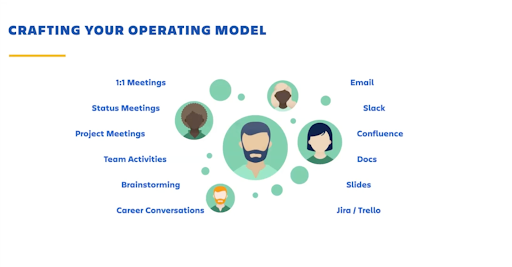
Whether you manage just a couple of people or have several layers under you with managers overseeing team leads overseeing multiple people, you need to create your own operating model.
By that, I mean you have several ways to engage your team and you have several tools at your disposal. You need to find the right combination to foster autonomy and competence to get the job done, as well as a sense of cohesiveness so each person feels they belong. With that in mind, I've put together a suggested framework you can modify for your needs and team.
This framework consists of three key elements:
- Play: Create a blueprint for how your team will work, communicate, and connect.
- Guide: Give your team clear direction and align their work to outcomes.
- Grow: Set expectations, provide feedback, and help your team grow in their careers.
Let's dive in, starting with Play, where you set up how your team works, communicates, and connects.
Step one: Play
There are some specific plays you can run to establish roles and responsibilities. The goal is to agree on how you meet, communicate, and work together.
Play #1: Roles and responsibilities
Let’s start with roles and responsibilities. First, you need to identify the work product marketing needs to focus on at your company. Based on your team size and members' skills, decide if people should specialize in specific areas like sales enablement and analyst relations, or take more of a generalist approach.
For example, one person might own messaging, another analyst relations, but all share responsibility for collateral. Depending on your company’s products, go-to-market strategy, and workflow, the organization of responsibilities will vary. The key is clearly establishing who owns what so each person knows what's expected of them.
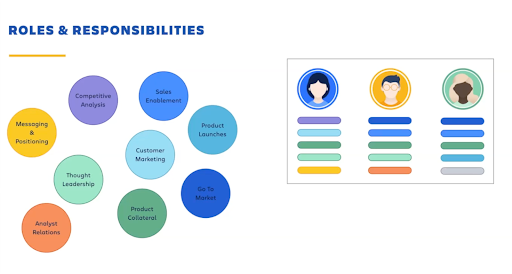
So, how do you get to that point? Well, you can run a roles and responsibilities play, using a whiteboard or online doc. Create three columns: roles, responsibilities (what others think), and responsibilities (what others think).
This exercise helps reveal any challenges the team might be facing. It also clarifies what each person's work entails. You may see that some team members don’t fully understand what they’re supposed to do, or that they’re duplicating others’ efforts and piling more onto their plates than necessary. As a manager, you can then clarify everybody’s roles and make sure the team is aligned.
Play #2: Work-life impact
The second play I like to run is all about helping the team to understand each other’s personal and professional situations so they can collaborate better. It’s especially useful for teams working in remote or hybrid environments. This exercise focuses on three key work-life impact areas and asks participants to mark their situation on a quadrant.
The first impact area is the home setup. It’s all about your physical workspace – do you live alone or share space with others? What are your household responsibilities and potential distractions? This is especially relevant in today's hybrid work environments where team members may spend significant time working remotely.
The second area is work style and collaboration preferences. Are you someone who thrives on social interactions and tight collaboration? Or do you prefer to work independently with longer periods of uninterrupted focus? Do you like people checking in frequently or do you prefer to be left alone? This helps uncover optimal workflows and communication styles.
The third area is the support network. How strong are your connections and relationships across the company? Are you a newer employee still building networks or a veteran who knows the organization inside and out? This is important because strong internal networks can aid in getting work done efficiently.
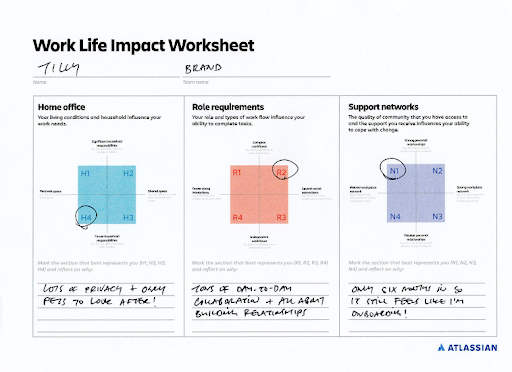
As each team member shares where they sit on these three matrices, important insights emerge.
Let’s take the example of Tillie. She explains that she lives alone so she has very few distractions to deal with. However, her role requires tight collaboration with colleagues she's just getting to know. As a newer employee, she lacks the connections that veteran team members have already built up, so she needs help meeting more people across functions to be more effective in her role.
Having everyone complete the matrices and share their results builds a mutual understanding of everyone's work situations, lifestyles, time zones, childcare needs, and other factors. The goal is to surface challenges early and head off issues proactively. As a manager, you can help make it a safe space by modeling openness and vulnerability yourself.
Play #3: Working agreements
In this helpful play, you essentially create a social contract for your team. It’s super simple to set up; you just need a collaboration document like a Trello board or a Confluence page or, if you’re doing this play in person, a whiteboard. This should be divided into three columns:
- Brainstorm – Where everyone can share their ideas
- As a team, we agree to… – Put ideas to a vote before adding them to this column
- Parking lot – For ideas that merit further discussion some other time
Use this play to establish things like how often the team will meet, what your main communication channels will be, and how you’ll manage different work types. This is a great way to set expectations early on.
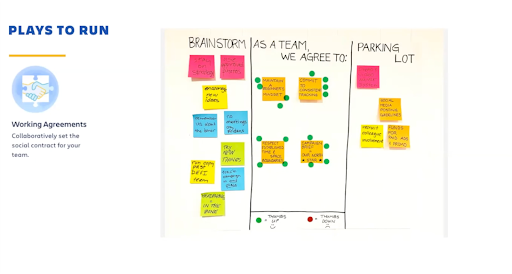
Play #4: Ritual reset
Every six months or so, it’s a great idea to sit down with your team and review what's working and what needs to change. Here are some questions you may want to discuss:
- Which meetings are effective?
- Which meetings are ineffective?
- Where is communication breaking down?
- How can you improve the ways you work together?
Look beyond your team
I’d recommend inviting the other teams you interact with - product, sales enablement, demand generation, and so on – to get in on the fun. Run plays together to align on launches, workflows, and rituals. The goal is to optimize collaboration across the organization.
Step two: Guide
Let's move to the next step in our operational model, which is all about providing clear direction, aligning your team around priorities, and connecting their work to key outcomes. I’m going to share some tools, plays, and tips that will help you make that happen.
First, ensure your team's goals and OKRs align with company objectives. If you can’t confidently say that a certain project maps to any of your goals, question whether that project should exist at all.
A tool like Atlassian's Atlas can be really handy here. It helps capture goals, projects, and team members on one screen. You can see which projects connect to each goal, and it shows each project’s status as well as the subscribers, who get automatic weekly updates via Slack or email, so they don’t have to keep pinging their colleagues to check that the project is on track.
Take the example below. The overarching goal is to increase customer engagement by 35%, and you can see the projects just below that will help the team work towards that goal. On the right-hand side, you can see additional goals that the team is working towards and projects that support those goals.
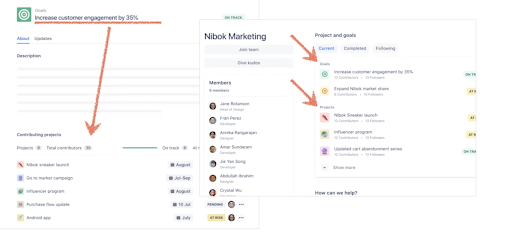
As a manager, this is a great way to track your team’s work and outcomes. Helpfully, you get a notification every time dates change within a project your team is working on. As your team grows, and the number of projects increases, a tool like this can be invaluable. Crucially, it also helps build that all-important autonomy. People know why they're working on something and how it ladders up to company goals.
Top tips for tracking your team’s projects
Whether you use a dedicated tool like Atlas or another project management system, here are some key tips for effectively tracking your team's work:
- Agree on a definition of “done”: It's important to align on what constitutes a completed task or project. This avoids the "watermelon effect" where it’s all green on the surface but once you cut it open, it’s all red. For example, if someone says a new product datasheet is 90% done, what does that mean? Will it take a week or a month to get to 100%? When can it be called fully complete – when there's a final draft, a polished PDF, or when it's uploaded to the website and in the sales team's hands? Define clear guidelines upfront.
- Agree on workflow stages”: Map out the process a piece of work must go through before it's considered complete. Who needs to review and approve content before it's published? Should you have columns on your Kanban board like "In Progress," "Done," and "Published" to visualize workflow? Outline the handoff points so nothing falls through the cracks.
- Create a backlog and prioritize: Have a centralized place to capture all incoming work requests, whether it's a sales enablement deck, new product video, or other collateral. New asks should go into this backlog queue. Then as a team, review the full list weekly and re-prioritize based on current business objectives. This ensures you tackle the most important projects first.
- Find your team’s rhythm: Over time, establish some regular rituals and cadences that optimize work progress and collaboration. This includes the frequency of check-ins, forums to discuss roadblocks, and norms around surfacing issues.
Following these tips will bring structure and visibility to your team's work, ensuring projects flow more smoothly.
Step three: Grow
The last piece of the operational model is Grow. It’s all about setting clear expectations for your team members to develop in their roles and advance their careers over time.
Now, depending on the size of your company, you may already have well-defined job levels and expectations within product marketing. But especially in startups and smaller companies, those structured roles may not exist yet.
If that's the case, PMA's Product Marketing Career Table is a great place to start. It outlines the expected skills and knowledge for associate PMMs, PMMs, senior PMMs, directors, and VPs.
When you're having career conversations with folks on your team – maybe a junior PMM wants to move up to senior or a senior wants to step into management – there are typically three areas that come up:
- Knowledge: What's the domain expertise expected for someone in this role at this level?
- Skills: What abilities do they need to master to succeed and grow? For example, sales enablement, creating presentations, conducting competitive analysis, and writing compelling copy – those may be core skills for their role.
- Behaviors: What work habits and attributes will set them up for excellence? Things like taking initiative, handling ambiguity, and collaborating smoothly across teams.
In your one-to-ones and check-ins, clearly outline your expectations across these three areas for that person's role now and for them to get to the next level. Then provide opportunities for them to gain knowledge, practice those skills, and exhibit the right behaviors to grow. It's all about being clear about the path to development.
Career competencies vs. craft competencies
When it comes to growth and development, another helpful lens is thinking about career competencies versus craft competencies.
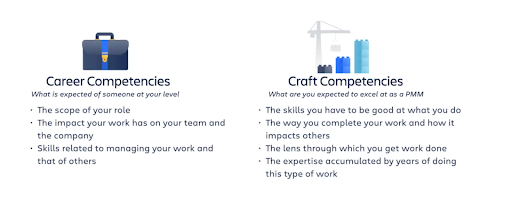
Career competencies include scope of responsibility and ability to manage work, which vary by level. Someone early in their career will have a very different role than an experienced senior team member. The expectations are different, as are the skills required.
Craft competencies are the product marketing knowledge, skills, and expertise that come from years of accumulating experience in this field. It's being highly skilled at the craft of product marketing.
As a manager, you need to coach team members on advancing their career competencies for their level while also developing their craft competencies to become experts in this discipline.
Coaching vs. directing
Something that helped me get better at this was understanding the difference between coaching and directing. This comes from the situational leadership model. Think of a spectrum. On the far left is directing – telling someone precisely what to do to complete a task. This is appropriate when guiding very junior team members.
But as you move right on the spectrum, you shift to more coaching. This means asking questions, listening, and guiding someone to arrive at solutions themselves. You want to develop their critical thinking skills.
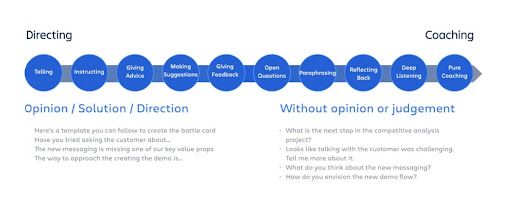
Early in my management career, I would stick too much to directing even with senior folks who could thrive with more coaching. Now I realize I need to assess the situation and tailor my approach.
A directing style works well for short-term goals where something needs to get done quickly. For example, if someone is new to creating a battlecard, you may need to provide precise instructions on how to put one together for an upcoming sales enablement session. Or if they're unfamiliar with some data, you'll have to clearly explain how to interpret it for an executive presentation due next week.
Directing is also useful when there are performance issues. You need to be clear in outlining the expectations that aren’t being met and why you're concerned.
In contrast, a coaching approach is better suited for long-term growth. Asking thoughtful, open-ended questions makes people reflect on challenges themselves to build critical thinking skills. For instance, if a customer call didn't go well, don't prescribe the solution. Instead, have your team members walk through what happened so they can consider better approaches for next time.
Similarly, don't hand them a demo script. Instead, give templates and examples to follow while letting them create the narrative. This builds their confidence and autonomy.
The key is flexibly blending both approaches based on the situation and person. This balance helps the team grow.
Closing thoughts
We've covered a lot of ground here! As a new manager, you're probably realizing just how many tools you now have at your disposal – one-to-ones, plays, team meetings, project reviews, coaching sessions, and so on. It can feel overwhelming.
You may be wondering, with all these new responsibilities, when will I ever find time to complete my own work? It’s a common concern.
The reality is, as a people manager, your focus does shift more towards your team. Your own projects take a back seat to providing direction, support, and career growth to your direct reports.
I've given a separate talk on time management for managers that goes into specific techniques you can use. The crux of it is that you need to carve out dedicated windows in your calendar for focused solo work.
You also need to be intentional about scheduling regular touchpoints with your team. Find a rhythm that allows you to balance your management duties with individual contributor work. For example, you might block Monday mornings for one-to-ones, Tuesday afternoons for giving feedback and coaching, Wednesday mornings for heads-down project work, and so on.
There's no one-size-fits-all formula, but be deliberate about planning your week and quarter. Get a sense of the cadence and intervals of interactions that enable you to support your team while still moving key projects forward. It takes practice, but you'll find your groove.
Finally, to recap the framework we covered today:
- Play is about your team working smoothly together,
- Guide is providing clear direction to your team, and
- Grow is developing team members' skills and careers
While we only scratched the surface, I hope this gives you some useful ways to think about structuring your new role as a manager.
Investing dedicated time in your people ultimately leads to great outcomes. Your team's success is your new purpose.
This article is based on Daniel’s brilliant talk at the Product Marketing Misunderstood event. PMA members can enjoy the session in its full glory here.


















 Follow us on LinkedIn
Follow us on LinkedIn



.svg?v=8154f0fdee)